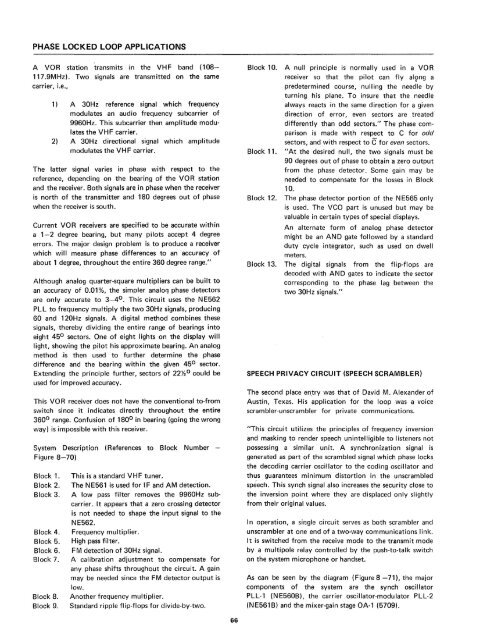section - Bitsavers
section - Bitsavers
section - Bitsavers
- No tags were found...
You also want an ePaper? Increase the reach of your titles
YUMPU automatically turns print PDFs into web optimized ePapers that Google loves.
PHASE LOCKED LOOP APPLICATIONSA VOR station transmits in the VHF band (108-117.9MHz). Two signals are transmitted on the samecarrier, i.e.,1 ) A 30Hz reference signal which frequencymodulates an audio frequency subcarrier of9960Hz. This subcarrier then amplitude modulatesthe VHF carrier.2) A 30Hz directional signal which amplitudemodulates the VHF carrier.The latter signal varies in phase with respect to thereference, depending on the bearing of the VOR stationand the receiver. Both signals are in phase when the receiveris north of the transmitter and 180 degrees out of phasewhen the receiver is south.Current VOR receivers are specified to be accurate withina 1-2 degree bearing, but many pilots accept 4 degreeerrors. The major design problem is to produce a receiverwhich will measure phase differences to an accuracy ofabout 1 degree, throughout the entire 360 degree range."Although analog quarter-square multipliers can be built toan accuracy of 0.01%, the simpler analoq phase detectorsare only accurate to 3-4 0 . This circuit uses the NE562PLL to frequency multiply the two 30Hz signals, producing60 and 120Hz signals. A digital method com bines thesesignals, thereby dividing the entire range of bearings intoeight 45 0 sectors. One of eight lights on the display willlight, showing the pilot his approximate bearing. An analogmethod .is then used to further determine the phasedifference and the bearing within the given 45 0 sector.Extending the principle further, sectors of 22%0 could beused for improved accuracy.This VOR receiver does not have the conventional to-fromswitch since it indicates directly throughout the entire360 0 range. Confusion of 180 0 in bearing (going the wrongway) is impossible with this receiver.System Description (References to Block Number -Figure 8-70)Block 1.Block 2.Block 3.Block 4.Block 5.Block 6.Block 7.BI·ock 8.Block 9.This is a standard VHF tuner.The NE561 is used for IF and AM detection.A low pass filter removes the 9960Hz subcarrier.It appears that a zero crossing detectoris not needed to shape the input signal to theNE562.Frequency multiplier.High pass filter.FM detection of 30Hz signal.A calibration adjustment to compensate forany phase shifts throughout the circuit. A gainmay be needed since the FM detector output islow.Another frequency multiplier.Standard ripple flip-flops for divide-by-two.Block 10.Block 11.Block 12.A null principle is normally used in a VORreceiver so that the pilot can fly al~ng apredetermined course, nulling the needle byturning his plane. To insure that the needlealways reacts in the same direction for a givendirection of error, even sectors are treateddifferently than odd sectors." The phase comparisonis made with respect to C for oddsectors, and with respect to C for even sectors.II At the desired nUll, the two signals must be90 degrees out of phase to obtain a zero outputfrom the phase detector. Some gain may beneeded to compensate for the losses in Block10.The phase detector portion of the N E565 onlyis used. The VCO part is unused but may bevaluable in certain types of special displays.An alternate form of analog phase detectormight be an AND gate followed by a standardduty cycle integrator, such as used on dwellmeters.Block 13. The digital signals from the flip-flops aredecoded with AND gates to indicate the sectorcorresponding to the phase lag between thetwo 30Hz signals."SPEECH PRIVACY CIRCUIT (SPEECH SCRAMBLER)The second place en.try was that of David M. Alexander ofAustin, Texas. His application for the loop was a voicescrambler-unscrambler for private communications."This circuit utilizes the principles of frequency inversionand masking to render speech unintelligible to listeners notpossessing a similar unit. A synchronization signal isgenerated as part of the scrambled signal which phase locksthe decoding carrier oscillator to the coding oscillator andthus guarantees minimum distortion in the unscrambledspeech. This synch signal also increases the security close tothe inversion point where they are displaced only slightlyfrom their original values.In operation, a single circuit serves as both scrambler andunscrambler at one end of a two-way communications link.It is switched from the receive mode to the transmit modeby a multipole relay controlled by the push-to-talk switchon the system microphone or handset.As can be seen by the diagram (Figure 8 -71), the majorcomponents of the system are the synch oscillatorPLL-1 (NE560B), the carrier oscillator-modulator PLL-2(NE561 B) and the mixer-gain stage OA-1 (5709).66
















